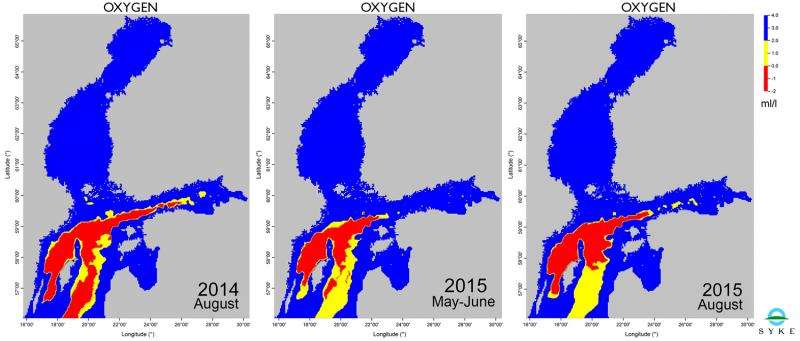Oxygen levels close to the sea floor in the Baltic Sea in 2014-2015. Credit: SYKE
The effects of the major Baltic inflow that reached the Baltic Sea in December 2014 are now reaching the mouth of the Gulf of Finland. However, the effects of the inflow have subsided, and it cannot completely oxygenate the hydrogen sulphide-rich water mass in the deep basins of the Baltic Proper. In the open sea area of the Gulf of Finland, the oxygen situation of deep water is better than last year. In contrast, the algae levels in both the Gulf of Finland and the Finnish Archipelago Sea were higher than they were in August 2014. These are the results of the recently concluded monitoring cruises of SYKE research vessels Aranda and Muikku.
The deep basins in the central parts of the Baltic Proper still have oxygen
The impact of the salty, oxygen-rich water that flowed into the Baltic Sea main basin (Baltic Proper) in December 2014 via the Danish straits was still visible in August up to the deep basins east of Gotland. Like the monitoring cruise in June, the one in August also found the water in the basins to the north of Gotland to be anoxic. Compared to Aranda's cruise in June, the area with oxygen-rich water to the north-east of the island of Gotland had diminished somewhat.
The heavier salty water flowing into the main basin has partially replaced the old eutrophic and anoxic water, which has in turn moved towards the mouth of the Gulf of Finland. Whether or not the anoxic water reaches the Gulf of Finland depends on the weather and current conditions during the coming autumn and winter.
The phosphate phosphorus content in the deep waters of the Baltic Sea main basin and the mouth of the Gulf of Finland has clearly decreased compared to what it was a year ago. Part of this phosphorus has been replaced by saltier water and moved into the higher water layers.
No significant amount of the deep water in the main basin can flow into the Gulf of Bothnia due to the thresholds in the seabed. As a result, the oxygen situation in the Bothnian Sea has remained relatively good, and the oxygen situation in the (basins of the) Bay of Bothnia is excellent. The phosphorus content in the deep basins of the Bothnian Sea has increased.
The oxygen situation in the Gulf of Finland has improved
The oxygen situation in the open sea basins of the Gulf of Finland was better than the last ten years. Hydrogen sulphide was only found in the deep areas near the coast of Estonia and the mouth of the Gulf of Finland. A central factor improving the oxygen situation from last year was that the eutrophic, low-oxygen deep water from the main basin has not flowed into the Gulf of Finland in the weather conditions of the past summer, unlike in the spring of 2014, for example.
The oxygen situation of the seabed and the water near the seabed in the sampling stations of the research vessel Muikku in the outer archipelago of the Gulf of Finland was also mainly good. The situation of the bottom sediment and the benthic communities was similar to the past five years. Year after year the seabed is revealed to be in bad condition in the same areas of the inner archipelago, where horizontal water exchange is poor and the seabed has large amounts of organic material that consumes oxygen.
The phosphate phosphorus content in the basins of the open sea areas of the Gulf of Finland was lower than last summer and roughly at the average level for the past ten years.
Higher algae levels than last August
The cool, windy early summer delayed the formation of extensive blue-green algal blooms. However, there were large amounts of blue-green algae at the end of August throughout the open sea area of the Gulf of Finland.
The chlorophyll-a content that represents the algae levels in coastal waters was higher than last year in both the southern areas of the Finnish Archipelago Sea and the Gulf of Finland. There were no significant differences in algae levels between the sea areas. The elevated algae levels were caused by the higher phosphate phosphorus content of the surface layer before the growth season compared to last year. Together with the calm, warm weather in August, this enabled the heavy algal blooms discovered in the last few weeks.
As for the increase in phosphorus content, it was caused by the phosphorus that in the summer of 2014 flowed in from the deep waters in the north of the Baltic Sea main basin and the phosphorus that was released from the Gulf of Finland's own seabed in the poor oxygen conditions and mixed with the surface layer during last winter. Despite the clear increase in algae levels compared to last summer, especially in the eastern Gulf of Finland, the eutrophication level of the sea area is still clearly lower than a decade ago..
The major Baltic inflow in the February-March period of last year and the large inflow in December in particular have so far interrupted the expansion of the anoxic area of seabed in the Baltic Sea main basin. The inflows and their resulting impact are likely to continue to affect the situation in the Baltic Sea main basin and the functioning of the ecosystem, and they are also indirectly reflected in the situation of the Gulf of Finland and the Gulf of Bothnia. The SYKE Marine Research Centre will continue to monitor and study the major Baltic inflow and its effects in close cooperation with other institutions studying the condition of the Baltic Sea and provide information about the results.
Provided by Finnish Environment Institute (SYKE)






















